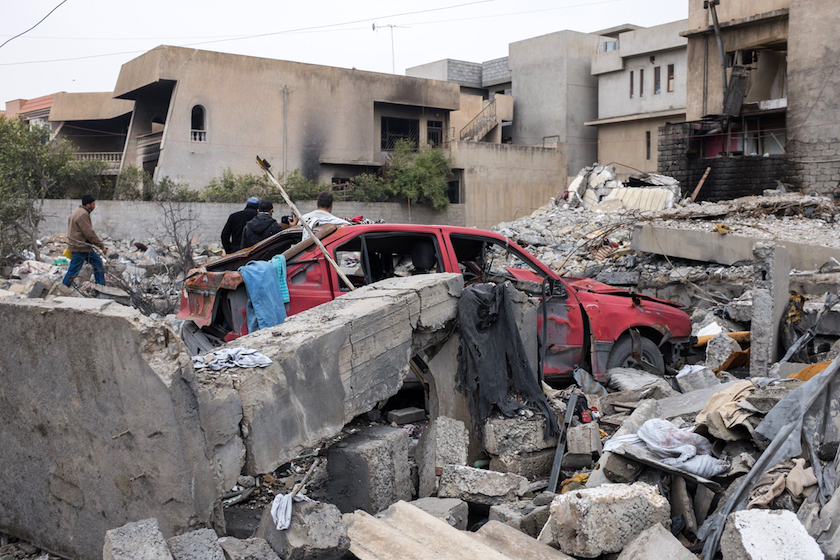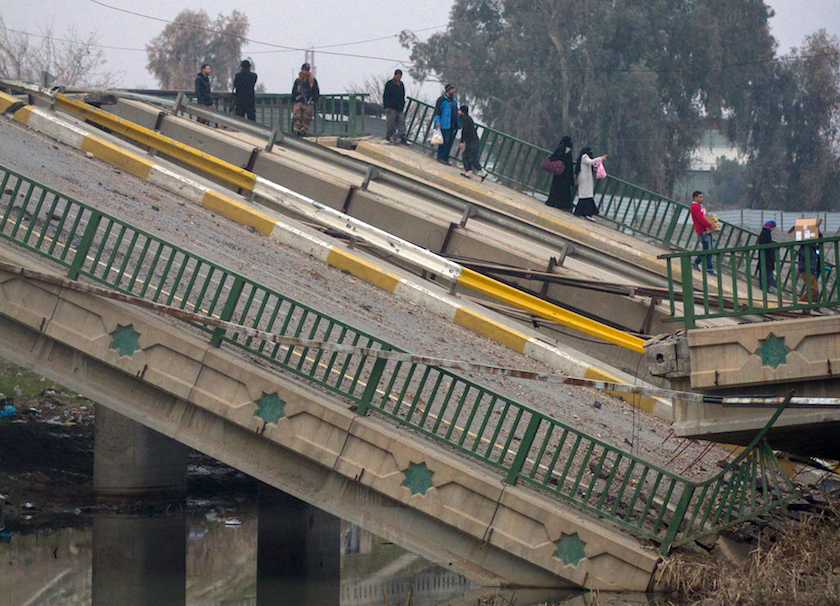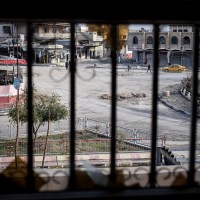“That’s their home.”
Uday pointed at the pile of rubble across the street from the aid delivery site.
“The destroyed one?
“Yes, yes, that one… they lost their house.”

It was hard not to stare, slack-jawed, as we surveyed the gaping void on the street corner.
The rest of the street remained lined with family homes. But this property—seized by ISIS and used as a command center—was bombed into oblivion.
The closer we drove toward the heart of Mosul that morning, the more evidence we saw of war lining the roads.
Bombed and burned-out buildings. Airstrike craters. Doorways shuttered in the vain hope of preventing damage.
With just the eastern half of Mosul liberated from ISIS so far, and the operation to retake western Mosul just beginning [as of February 2017], estimates for rebuilding this once-vital city already range in the billions of dollars.
From our visits to the city, we see three distinct kinds of destruction in Mosul.
1. City infrastructure
Armed forces on all sides are responsible for the destruction in Mosul. ISIS laid waste to the city in order to control it. The Iraqi army, militias, and international coalition forces have bombed their way through the city to regain territory, one painstaking neighborhood at a time.
Violence isn’t tidy, and many of the “bones” of the city are now broken.
Those properties which make a city functional were particularly targeted. City streets are cratered with the impact of air strikes. Bridges are folded up like paper street maps. Power generation and water filtration plants are damaged. Hospitals, government facilities, the university, businesses and upwards of a thousand homes have been shelled so far.

There are certainly sections of Mosul which, so far, have weathered the war relatively unscathed. But the overall level of destruction is alarming, and isn’t over yet.

Even after ISIS is finally pushed out of the city, many buildings damaged during the war will be too unstable to repair. And ISIS’s thorough technique of booby trapping structures will require some of them to be completely destroyed if they cannot be made safe.
2. Human infrastructure
It’s easy to think of a city in terms of its buildings, but it’s the people who live there who make up a community.
Mosul’s residential loss has been profound.
Many with financial means fled the city before ISIS closed the doors of escape. Civil servants, doctors, engineers, teachers, and others who would be sure targets have had three years to establish new lives in other places.
Some will return home when Mosul is safe—but not all of them.
Of the residents who stayed—many of whom couldn’t afford to leave—thousands were killed directly by ISIS and more by the spillover effects of war. Many of these residents made up the body of workers in the city. They were the shopkeepers, bakers, tea cart vendors, construction workers, taxi drivers, and retired workers who support the local economy.
Current reports suggest that ISIS is using these remaining civilian population in western Mosul as human shields, ensuring that there will be still more war casualties.
The loss of human life in Mosul has left voids far more devastating than the loss of physical infrastructure.
3. Trust
Bonds of trust in Mosul have been severed as cleanly as any of Mosul’s destroyed bridges.
Neighbors and families are torn, as some in their midst chose to join or support ISIS. They are torn because the myriad ties that crossed religious and cultural boundaries before ISIS’s presence were used by some to gain personal leverage, instead of to form a cohesive defense. They are torn because many felt abandoned by the national government and military when ISIS first came on the scene in strength.

Together, we’re already meeting needs in Mosul. But when the military ends its campaign to retake Mosul, we won’t be pulling out with them. We are staying in Mosul to help rebuild—investing in Iraqi people through small business grants to help residents get back to work and take care of their families, and through medical clinics that provide needed health care.
It’s not easy to share stories like these, but it’s important to understand the level of damage in Mosul, so we know what we’re in for. Together.
Thank you for showing up—and continuing to show up—for the people of Mosul.


